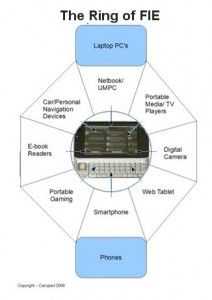Everyone is free to make their own definition of a MID. Intel like to define it as a pocketable web-capable device. Dell used the expression for netbooks at one point and I’ve talked about a wide-ranging Ring of FIE (right) which includes MID-like, internet-connected devices that don’t even need a browser. It looks like ISuppli take a similar idea and use it for their definition of a mobile internet device.
EETimes reported a few weeks ago.
ISuppli (El Segundo, Calif.) defines MIDs as devices that have integrated connectivity for wireless local area network (WLANs), wireless metropolitan area networks or 3G-or-higher worldwide wide area networks. They also must a maximum-sized display of 8-inches in the diagonal dimension, an instant-on function, an always-connectable capability and a full day’s worth of battery life under typical usage scenarios, according to the firm’s definition.
Far enough. But what about the statement on smartphones?
Smartphones are projected to dominate the MID segment in the forecast period from 2008 to 2012, iSuppli said. The firm estimates that about 60 percent of all smartphones now are considered MID-class devices, but that figure will rise to cover 100 percent by 2012.
I agree that smartphones (if we continue to call them that) may dominate numbers as they move up the chain in terms of sizing, software and processing capability but I certainly wouldn’t class 60% of all smartphones as MIDs today.
As I said, definitions vary so despite my reservations about those smartphones, if you’re researching the sector you might want to be buying a copy of the ISuppli report.












New article: ISuppli: 60% of Smartphones are MIDs http://cli.gs/50VaBP
Ugh. I hate all of these ambiguous definitions for MID, UMPC, etc.
For me, it’s not a MID if a) it’s not pocketable (so, 8″ is way too big a ceiling in their definition), and b) it doesn’t have a desktop quality OS that you can mostly/fully access. And I’ll accept if some argue that it has to have an Atom type Intel CPU. Certainly Windows MIDs have to have an x86 compatible CPU, but Linux MIDs don’t necessarily have to have one (because you can generally just recompile Linux apps for ARM, etc.). Just having an internet connection of some sort, and a web browser, aren’t enough.
So, Android: not a MID OS, because even though it’s Linux based, it doesn’t give you most/all of the access to the Linux OS. Maemo, however, is a MID OS, because it gives you full access to the Linux layer.
Smartphones: Blackberry: not a desktop OS, thus not a MID. iPhone: … not a full desktop OS X experience, so, no (just like Android, in this regard). Windows Mobile phones: no. Symbian phones: no.
This is in some ways similiar to the posts about the UMID, only this time about the definitions.
I agree with John it can’t be a MID if it isn’t pocketable. However MIDs weren’t originally going to have a desktop OS in them but where aimed specifically at the FIE criteria – Mobile (size, weight) Internet (WLAN, WWAN, Browser) Device. Most smartphones are therefore MIDs. They might by rubbish at implementing the browser part – too slow, too small, can’t run flash etc. but as long as they are small enough and do allow that connectivity then they are MIDs. This is where I see a difference with UMPCs, because a UMPC has a Full Desktop OS.
I will make do with a decent MID and would like to combine it with a phone as I don’t want too many devices in my pockets, but what I really want is a UMPC.
This is due to loads of software I own and want to use on-the-go. This is all Windows compatible. If I didn’t have this and could run what I want on WinMo then I wouldn’t care that it isn’t a Full Desktop OS and would just want a decent docking station at home and get rid of the desktop altogether.
MIDs must have Instant On and a full day’s worth of battery? That leaves out almost everything with Windows OR Linux! Only some ARM devices qualify.
Event then, they aren’t instant on. They’re always-on (in low-power states) My phone takes a minute to start up from cold!
ISuppli need to refine their definition I think!
Reading & agreeing with: ISuppli: 60% of Smartphones are MIDs | UMPCPortal – The Mobile Internet and Computing Ref. st – http://is.gd/pLbZ